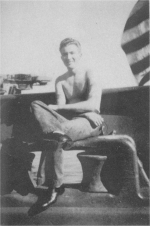
| 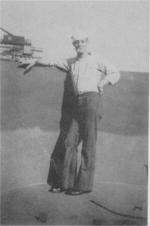
| 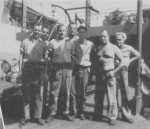
|
Please report any broken links or trouble you might come across to the Webmaster. Please take a moment to let us know so that we can correct any problems and make your visit as enjoyable and as informative as possible.
All images in this section are taken from the cruise book. Narrative has been transposed and added to the photos where appropriate.
"FOR THE NEXT TWO YEARS, San Francisco was to represent America to the crew. Passing under the Golden Gate Bridge meant stateside liberty! fourteen trips to the islands of the Pacific climaxed in a return to the city.
Always a favorite port for the crew. San Francisco afforded a rollicking time, despite the fact that money disappeared in a short period. Stories have been told of sailors greasing the rails of the cable cars, making the descent of California Street uninterrupted, and much faster than usual.
Rationing of golf balls limited the joy of playing on the city's golf links, particularly with the dog leg hole leading into the ocean. Swimming was too cool for comfort after the men became accustomed to the South Pacific beaches.

| 
| 
|
An hour before sunset the ship's personnel mingled with the crowd gathered at the 'Top of the Mark', selecting the choice window seats and watching the night creep up on the city. Later in the evenings the International Settlement felt the presence of the 'Mount Vernon' gang. 'Nellie' Nelson announced his arrival in one bar filled with Coast Guardsmen by shouting, 'Standby, shallow water, Let the deep blue sea roll in!' The Coast Guardsmen became seasick when they saw his escorts; Boden, Butler, and the rest of the ship's gunners mates, and the sea rolled in.
Eating places and bars were found everywhere. In fact, a marriage was performed in one of the bars, with the crew of the 'Mount Vernon' participating. Those who felt too crowed in the city proper spread out over the bay area and in the towns down the peninsula.
Ships must sail however, and accomplish their missions. The 'Mount Vernon' was no exception. She left San Francisco on various trips bound for Adelaide, Sydney, and Melbourne, Australia; Auckland and Wellington, New Zealand; Noumea, New Caledonia; Suva, Fiji; Milne Bay, New Guinea; Honolulu and Pearl Harbor, Hawaii; and Bombay, India. Even San Francisco could not hold a troopship forever.
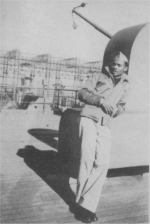
| 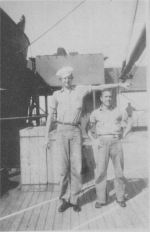
| 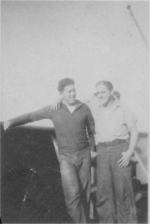
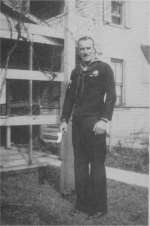
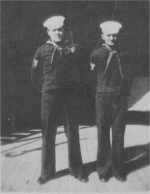
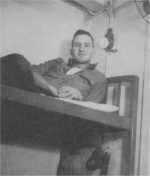
|
Adelaide, Australia is about an hours's train ride up the river from the port. The train, running from the port to the city, is pulled by an engine purchased from the states; the model was popular here in the eighteen hundreds, and the train jerks, and tosses, and stops, it seems, every several hundred yards.
Cut off from the rest of Australia by a chain of mountains, the city is a quiet, overgrown country town. Like all cities of English design, it appears old and worn. Adelaide is not large, but what it lacks in size, it makes up in the number of pubs. There were no activities until evening, then, in the blackout, the glow of cigarettes, marked the lines of people awaiting entrance to the theaters. In the blackout the sound of footsteps was amplified. This sound rose in volume as the theaters loosed their crowds onto the streets.
Several dances were held for the entertainment of the Yanks. The last night in port a dance was scheduled, but liberty was canceled. There was a mass ship-jumping move, and by 1900 the ship was deserted. Working parties on the dock, under supervision of Dudley, suddenly had cargo nets filled with sailors headed for town. At the time the ship was in possession of oversized G.I. cans. One of the men, in dress blues, secreted himself in the can, had a couple of fellows cover him with newspapers, carry him to the dock, and set the can down behind some packing cases, where he climbed out and took off. Other men were able to get off over the stern lines.

| 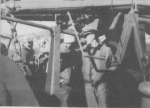
| 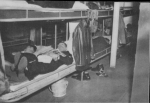
| 
|
Upon returning, the boys solved the problem of boarding the ship in an equally ingenious manner. Over in cargo nets they came. Some, borrowing leggings, the long coats, and the hats of the Aussie soldiers working on the dock, boldly walked aboard, saluted the O.O.D. and said that they were to work in the hold that was being loaded. It suddenly occurred to the O.O.D. that a very large number of Aussies were coming aboard, especially when he saw a cargo net filled with coats, hats and leggings leaving the ship from number six hold. The next man, be stopped--it was a sailor. Ten men in all came aboard reporting that they were Ramos, S1c, relieved from gate watch. Lt. Harvey called Midshipman O'Riley and ordered him to make a tour of the ship to stop the illegal returning aboard. A man, in a soldier's coat was part way up the stern line. O'Riley ordered him back and when he continued on toward the ship pulled his '45'. With the remark 'You win!', the man crawled back and presented himself to the O.O.D.. Mr. Harvey caught another in a Digger uniform, and, at the point of a gun marched him aboard and arrested him. A more successful means of returning to the ship was climbing down the dock, walking along the camel, and entering the fuel port.
All in all, there were 48 deck courts, and 8 summary courts. The ship never returned to Adelaide.
SYDNEY claimed to be a second New York. In a few ways, they are comparable. Both have their harbors, New York has her Central Park, Sydney has her Domain. The contrast between the bright lights of Central Park and the blacked-out Domain was obvious; two of the chiefs carried blankets ashore.
The Troc was the 'Mount Vernon's' while she was in town. The Baltimore made larger sandwiches; the waitresses never left the plates, but jerked them off the table as soon as the customer finished. Replacements were impossible to find.
Sydney did have food, rare items such as Pig Trotters in jelly at the Carleton, Toheroa soup from Adam's Fish Cafe, a peculiar gray liquid called coffee. Milk bars stood at every corner.
Traffic was a bother, they were going the wrong way on the right side of the street. Busses carried their gas bags on the tops. The people of King's Cross learned not to call the Americans 'Yanks'. Most of the southern men of the ship pounded the information into their heads.
Brake had never been seasick aboard the ship. The ferry to Luna Park accomplished what the 'M.V.' could not do. Leaning over the tail, he lost his balance, and landed in the drink. The ferry stopped. He was fished from the water.
Luna Park was at the foot of the Sydney Bridge, across the bay from Woolomolo. Any night of the week, a muster of the sailors included the entire liberty section. Durst was discovered on his hands and knees sifting in the sands. Attempting to be helpful, Jack Parsons wandered down started searching, too.
In Sydney Captain E.P. Eldredge reported aboard after flying from San Francisco and relieved Captain P.P. Powell. The change of command ceremony followed the standard order of procedure. Following the reading of orders, the new commanding officer shook hands with his officers as they were introduced to him.
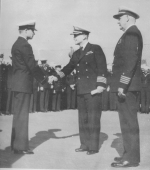
|
The exact opposite of Sydney is Melbourne, a quiet residential town. For some unknown reasons, the navigators were not able to bring the ship closer to town than the 45 minute train ride distance.
After leaving the train at the Central Station, following through the subway, and rising to the street level, the American literally bumped into the mass of humanity. Having just come from the States, he, of course, forgot that the Aussies walk 'on the wrong side of the street.'
Ship's company checked up on souvenirs: Urban and Honor in the jewelers looking at opals, DesRosiers considering the purchase of a hand carved chess set, only to find that the store had been closed for an hour.
Trees grew from the sidewalks of Elizabeth Street. Arm and arm, the ship's company and the Aussie girls giggled at each others accents. Cline and Rowe had the misfortune of ordering doughnuts in a restaurant which sold American coffee."
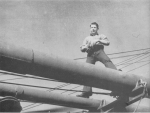
| 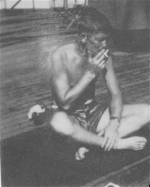
| 
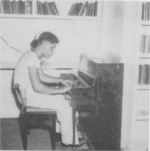
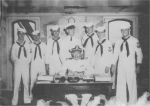
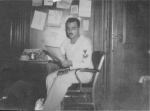
|
| Comments, Suggestions, E-mail Webmaster. |
|
This page is created and maintained by Gary P. Priolo |